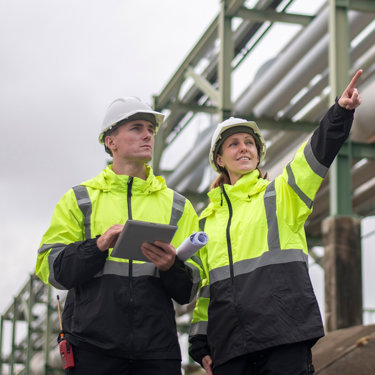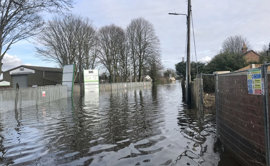What the Environment Act 2021 targets mean for your organisation
Published: 31 May 2023
On 7th February 2023 The Environment Act 2021: environmental targets came into force confirming the environmental targets and the corresponding legislation. At this point these targets only apply to England.
In parallel, the UK government also published their Environmental Improvement Plan 2023 and the findings of their Significant Improvement Test, both on 31st January 2023. These document the consultations and decision-making process behind the environmental targets as well as the environmental commitments made by Government.
In this blog, Hugo Jenkins, Head of Water and Ecology, discusses the potential implications of the Environment Act 2021 targets and what it might mean for your organisation.
There is huge focus on water, agriculture, and the natural environment, through infrastructure and asset transformation, monitoring and advisory support, and sustainability, biodiversity, and carbon Net-Zero expertise.
The targets are just the beginning. They will drive policy and regulation. It will be the responsibility of The Environment Agency (EA) in England to provide data to the Secretary of State in relation to the targets in these Regulations.
Water
We are expecting the EA to focus its attention on the water and wastewater companies. With only 14% of UK waterways in good ecological health currently, the progress on targets around nutrients from wastewater will be monitored by water companies and reported to the EA. However, it feels like a wasted opportunity not including measures to tackle highway and urban runoff pollution to water.
The EA is reviewing its auditing practices for monitoring of wastewater treatment works by water companies. It has said that it will take enforcement action against water companies failing to meet agreed standards under the Environmental Permitting Regime. If we are to see success, water companies will need to share more information and become more transparent.
Nutrient pollution from phosphorus is the most common reason water bodies fail to meet ‘good status’ under the Water Framework Directive, according to the government. With the pollutant impacting 36% of water bodies currently, Water UK estimates that by 2030 there will be a 90% reduction in phosphate compared with 1990 levels.
Expect to see tighter regulation around trade effluent discharge consents for all organisations. Greater sampling and analysis may be required with additional treatment and minimisation of discharges to ensure you remain compliant.
Another focus of the targets will be agriculture with phosphorus and nitrogen pollution from farming two of the leading causes of UK river pollution. DEFRA’s Environmental Land Management scheme (ELMs) is going to be an important mechanism for delivering the 40% reduction target for all catchments.
With regards to the target set for abandoned metal mines, the interpretation of the target including mines connected to “metalliferous and industrial minerals”, could draw in coal. The Coal Authority might then become partly responsible for non-compliance but the Government also acknowledges that the original operators also cannot be identified in lots of cases (“polluter pays”) so the responsibility must fall on the Government then?
Biodiversity
Delivering a 10% biodiversity net gain will become a mandatory requirement for almost all developments from November 2023. Natural England has also started selling nutrient neutrality credits to developers this April, and the Levelling Up and Regeneration Bill will change the environmental impact assessment regime.
To realise environmental improvements, the Government will need to be able to monitor the progress being made at an individual organisation level. To achieve this, progress will be tracked and regulatory through the planning permission process with local authorities.
Air pollution
Farming, construction, and wood burning are all listed as areas of opportunity to improve air quality. Expect more regulations around carbon reporting and Net-Zero planning for organisations in the coming decade. To monitor carbon, you need to perform a series of energy and carbon audits of your organisation’s scope, 1, scope 2 and scope 3 greenhouse gas emissions. From this initial monitoring you can create a baseline and begin to build a Net-Zero plan. Identifying key areas of energy usage has other benefits including helping you to reduce business costs.
Waste
The waste targets have been widely criticised as not going far enough and missing an opportunity to focus on production and resources. Better data will certainly be needed to track progress, which means DEFRA picking up the pace on mandatory digital waste tracking (part of the Environment Act).
Tangible methods for meeting and measuring the targets
At this stage there are no clear mechanisms for how organisations should go about their duties. It is thought likely that it will be a combination of some form of centralised, yet-to-be-published guidance, with processes devised by the EA, DEFRA, and the local authorities.
Wherever the responsibility lies, no doubt organisations will look to their supply chains to share as much risk as possible, along with identifying solutions.
The other angle is an organisation’s position on complying with the targets on a voluntary basis. Doing the right thing, organisations can look to enhance their reputation and commercial advantage in a responsible way.
The targets
Annual Mean Concentration Target for PM2.5 - The annual mean concentration target is that by the end of 31st December 2040 the annual mean level of PM2.5 in ambient air must be equal to or less than 10 µg/m³ (“the target level”).
Population exposure reduction target for PM2.5 - The population exposure reduction target is that there is at least a 35% reduction in population exposure by the end of 31st December 2040 (“the target date”), as compared with the average population exposure in the three-year period from 1st January 2016 to 31st December 2018 (“the baseline period”), determined in accordance with regulation 8.
The target is that before the end of 31st December 2042—
(a) the number of protected features which are in favourable condition within all relevant Marine Protected Areas (MPAs) is not less than 70% of the total number of all protected features within relevant MPAs; and
(b) all other protected features within relevant MPAs are in recovering condition.
Agriculture water target
The first target in respect of water is that the load of each of the following—
- total nitrogen,
- total phosphorus,
- sediment,
entering the water environment through agricultural diffuse pollution is, by 31st December 2038, at least 40% lower than the baseline.
Waste water target
The second target in respect of water is that the load of total phosphorus discharged into freshwaters from relevant discharges is, by 31st December 2038, at least 80% lower than the baseline.
Abandoned metal mines water target
The third target in respect of water is that the length of relevant waters polluted by any of the following—
- arsenic,
- cadmium,
- copper,
- lead,
- nickel,
- zinc,
from abandoned metal mines is, by 31st December 2038, at least 50% lower than the baseline.
Water demand target
The fourth target in respect of water is that the volume of potable water supplied per day per head of population in England is, by 31st March 2038, at least 20% lower than the baseline.
The residual waste long-term target is that by the end of 31st December 2042 the total mass of residual waste for the calendar year 2042 does not exceed 287 kilograms per head of population in England.
“Residual waste” means any waste, other than excluded waste, which—
- originated in England; and
- is treated by a method specified below in the year in question.
- sent to landfill in the United Kingdom;
- put through incineration in the United Kingdom;
- used in energy recovery in the United Kingdom; or
- sent outside the United Kingdom for energy recovery.
Species’ extinction risk target
The long-term biodiversity target for species’ extinction risk is to reduce the risk of species’ extinction by 2042, when compared to the risk of species’ extinction in 2022.
Wildlife-rich habitat restoration or creation target
The long-term biodiversity target for the restoration or creation of wildlife-rich habitat is that on or after the day these Regulations come into force, in excess of 500,000 hectares of a range of wildlife-rich habitats are to be restored or created by 31st December 2042.
2030 species abundance target
The 2030 species abundance target is that the overall relative species abundance index on the specified date indicates that the decline in the abundance of species has been halted.
The specified date for the 2030 species abundance target is 31st December 2030.
Long-term biodiversity target to reverse the decline of species abundance
The long-term biodiversity target to reverse the decline of species abundance is that the overall relative species abundance index by 31st December 2042 is—
- higher than the overall relative species abundance index for 31st December 2022; and
- at least 10% higher than the overall relative species abundance index for 31st December 2030 (the specified date for the 2030 species abundance target).
2050 Target
This regulation specifies a long-term target in respect of the percentage of land in England covered by woodland and trees outside woodland.
The target is that by the end of 31st December 2050 at least 16.5% of all land in England is covered by woodland and trees outside woodland.
More from our Knowledge Hub
Environmental compliance today, creating a sustainable tomorrow
Helping you reduce risk to the environment and your operation by managing assets compliantly while achieving commercial, ESG, and net-zero goals.
Contact our experts




